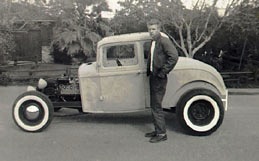 MAYBE THAT’S ALL I’VE EVER BEEN. Simple as that. Seeing my first hot rod at age 8 in San Leandro, my head spun around to follow it in traffic behind us. “What was that?” I asked my Dad, driving us somewhere in the family Buick. “That’s a hot rod,” he answered, to which I asked further, “Who makes them, or where do they come from?” “Hobbyists make them from old and new parts,” Dad answered.
MAYBE THAT’S ALL I’VE EVER BEEN. Simple as that. Seeing my first hot rod at age 8 in San Leandro, my head spun around to follow it in traffic behind us. “What was that?” I asked my Dad, driving us somewhere in the family Buick. “That’s a hot rod,” he answered, to which I asked further, “Who makes them, or where do they come from?” “Hobbyists make them from old and new parts,” Dad answered.
He knew I was moved and impressed. A few months later he said I could go to the Oakland Roadster Show down by Lake Merritt and I did; it was fantastic! Every imaginable old modified Ford or Chevy with glistening chrome and brakes with a huge engine, and glorious paint and gorgeous wheels, were there to impress. My head and heart must have exploded!
Shortly thereafter I got my first .049 model airplane engine with an ignition battery and a small can of fuel. It was absolutely exciting! You could clip the battery to the Glowplug at the top of the engine, fill the small gastank at the rear of the engine and then squirt a small amount of primer fuel into the exhaust port, flip the propeller over and listen to the fuel sizzle at the Glowplug. A few more propeller flips and the fuel would ignite. Not enough to start the engine but enough to Pop! and make your heart and your blood race. Or it would backfire and reverse the propeller and give your finger a good, unexpected chop. A few of those and you quickly learned to remove your finger fast from the area of the propeller after each flip.
Then turn the fuel mixture valve up or down by a half turn and try again. The fuel-to-air mixture was now just right, and the engine ignited. It was mounted securely in a vise in the garage or my upstairs bedroom and therefore wasn’t going anywhere, but it screamed that it was ready to fly! Next, quickly remove the battery clip — the engine heat would sustain the glow of the Glowplug to keep the fuel ignited — and further turn down the fuel mixture screw to peak, screaming performance and burn up the entire two- or three-minute fuel load in the tank!As quickly as it had started, it was now over. The propeller rocked to an abrupt stop. The spent fuel was now a sweet exhaust essence in the air, the exhaust port and rear of the engine and tank were covered with a slightly more dense, light oily mixture, and you had just had the mechanical thrill of a lifetime.
Next to buy: a plastic model airplane with control strings to fly on the front lawn after we moved to Walnut Creek in 1953. But the front lawn wasn’t that deep so instead of your flight control strings being maybe 30 or so feet in length, you laid them out with all the room you had between the house and the front junipers, maybe only 10 feet. Then ask a younger brother to hold the airplane’s tail after you started the engine, then run to the center of the lawn to fly it. BUT since your strings are now three times too short, you spin around three times too fast, get dizzy and fall over and the plane crashes! In years to come you’ll take your accumulated stuff to the nearby park or school playground and actually fly it with full-length strings.
But now it’s time to paint the fenders of your fat-tired Schwinn and in no short order get that metallic green English racing bike AND a used Briggs & Stratton lawn mower engine from that lawn mower shop up on Geary Road and build your first wooden Go-Kart! Awesome!
The Go-Karts were a kick in the pants, and before long I had my first 1950 Ford coupe and then another and a 1932 Ford five-window coupe and the grandparents’ 1936 LaSalle that my parents had dated in. BUT high school was over, community college started and I had to focus on becoming a serious student. I commuted to school from my parents’ home in Walnut Creek in a 1960 Ford Falcon, two-door … I never counted the cylinders — maybe four? By the time I was a married student at Berkeley as a senior I bought it from my parents for the balance remaining. I had summer jobs in engineering and got it painted. Later I traded it in for my 1965 Chevelle Super Sport two-door hardtop! Hot stuff! In time it got old and I bought a VW bug to commute in. Then a 1970 Datsun truck complete with chrome rims and blackwall tires. Hot stuff!
That eventually wore out in time and I bought the Old Gold 1972 Chevy station wagon. In time I put chrome rims and black walls on it with air shocks and it was VERY hot stuff. With BLACK interior upholstery. Nice vehicle! But things wear out and I bought another commuter vehicle, a 1984 Chevy Cavalier station wagon, dark blue. It was fine but shortly after making the last payment on it I was rear-ended at the southern approach to the Benicia-Martinez Bridge by a drunk and the car was a total wreck. I was OK. So I bought a 1989 Toyota 4-wheel-drive truck — anyone hitting me from the rear was going to have to eat some serious steel.
That wore down in time and was replaced by another Toyota truck, the Silver Travois. That in turn was replaced by my current vehicle, the Tan Pony, a 2003 Toyota Tacoma pickup, 5-speed, with lumber rack and camper shell that I had on all the other Toyotas. Life goes on.
Cars and trucks are cool. Very cool. They form an attitude of life, they must functional, but they can also be visually exciting. Like home, marriage, kids, poems, songs, graphic design projects, websites and front and backyard architecture. It’s a way of life. A definite attitude — functionality with coolness.
Peter Bray lives, works and writes in Benicia.







Leave a Reply